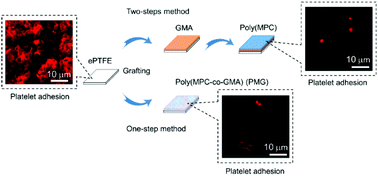当前位置:
X-MOL 学术
›
Biomater. Sci.
›
论文详情
Our official English website, www.x-mol.net, welcomes your
feedback! (Note: you will need to create a separate account there.)
A surface graft polymerization process on chemically stable medical ePTFE for suppressing platelet adhesion and activation†
Biomaterials Science ( IF 5.8 ) Pub Date : 2018-06-07 00:00:00 , DOI: 10.1039/c8bm00364e Yihua Liu 1, 2, 3, 4 , Maria Chiara Munisso 1, 2, 3, 4 , Atsushi Mahara 1, 2, 3, 4 , Yusuke Kambe 1, 2, 3, 4 , Kyoko Fukazawa 4, 5, 6, 7, 8 , Kazuhiko Ishihara 1, 2, 3, 4 , Tetsuji Yamaoka 1, 2, 3, 4
Biomaterials Science ( IF 5.8 ) Pub Date : 2018-06-07 00:00:00 , DOI: 10.1039/c8bm00364e Yihua Liu 1, 2, 3, 4 , Maria Chiara Munisso 1, 2, 3, 4 , Atsushi Mahara 1, 2, 3, 4 , Yusuke Kambe 1, 2, 3, 4 , Kyoko Fukazawa 4, 5, 6, 7, 8 , Kazuhiko Ishihara 1, 2, 3, 4 , Tetsuji Yamaoka 1, 2, 3, 4
Affiliation

|
An effective surface grafting method for chemically inert and elaborately porous medical expanded-polytetrafluoroethylene (ePTFE) was developed. Although surface graft polymerization onto basic polymeric biomaterials has been widely studied, successful modification of the ePTFE surface has been lacking due to its high chemical resistance. Herein, we succeeded in surface graft polymerization onto ePTFE through glycidyl methacrylate (GMA) as a bridge linkage following argon (Ar) plasma treatment. The epoxy group of GMA was expected to react with the peroxide groups produced on ePTFE by Ar plasma exposure, and its methacrylic groups can copolymerize with various monomers. In the present study, we selected 2-methacryloyloxyethyl phosphorylcholine (MPC) as a model monomer and the blood compatibility of modified ePTFE was evaluated. Two sequences of surface grafting were compared. In a two-step graft polymerization, GMA was first immobilized onto Ar plasma treated ePTFE, and then MPC was polymerized. In a one-step graft copolymerization, MPC and GMA were mixed and copolymerized simultaneously onto Ar plasma treated ePTFE, resulting in a poly(MPC-co-GMA) (PMG) graft surface. The roughness of the node-and-fibril structure of ePTFE was reduced by the uniform polymer layer, and the modified ePTFE had a good hydrophilic nature even after being stored in an aqueous environment for 30 days. The indispensable GMA in graft polymerization improved the surface grafting on ePTFE. The one-step and two-step graft polymerization methods could decrease the number of adhered platelets, and almost inhibit platelet activation. We concluded that graft polymerization with the GMA linker provides a novel strategy to modify the chemically inert ePTFE surfaces for functionalizing as new medical devices.
中文翻译:

化学稳定的医用ePTFE表面接枝聚合工艺可抑制血小板粘附和活化†
研制了一种有效的表面惰性化方法,用于化学惰性和精细多孔的医用膨体聚四氟乙烯(ePTFE)。尽管已经广泛研究了在碱性聚合物生物材料上进行表面接枝聚合反应,但由于ePTFE表面的高耐化学性,因此尚未成功对其进行改性。在本文中,我们成功地在氩气(Ar)等离子体处理之后,通过作为桥键的甲基丙烯酸缩水甘油酯(GMA)将表面接枝聚合到ePTFE上。预期GMA的环氧基会与通过Ar等离子体暴露在ePTFE上产生的过氧化物基反应,并且其甲基丙烯酸基团可以与各种单体共聚。在本研究中,我们选择2-甲基丙烯酰氧基乙基磷酰胆碱(MPC)作为模型单体,并评估了改性ePTFE的血液相容性。比较了两个表面嫁接序列。在两步接枝聚合中,首先将GMA固定在Ar等离子体处理过的ePTFE上,然后将MPC聚合。在一步接枝共聚中,将MPC和GMA混合并同时共聚到Ar等离子处理过的ePTFE上,得到聚(MPC-co- GMA)(PMG)移植物表面。通过均匀的聚合物层降低了ePTFE的节状和原纤维结构的粗糙度,并且改性的ePTFE甚至在水性环境中储存30天后仍具有良好的亲水性。接枝聚合中必不可少的GMA改善了在ePTFE上的表面接枝。一步和两步接枝聚合方法可以减少粘附的血小板数量,并几乎抑制血小板活化。我们得出的结论是,使用GMA接头进行接枝聚合提供了一种新颖的策略,可修饰化学惰性的ePTFE表面,以用作新型医疗设备。
更新日期:2018-06-07
中文翻译:

化学稳定的医用ePTFE表面接枝聚合工艺可抑制血小板粘附和活化†
研制了一种有效的表面惰性化方法,用于化学惰性和精细多孔的医用膨体聚四氟乙烯(ePTFE)。尽管已经广泛研究了在碱性聚合物生物材料上进行表面接枝聚合反应,但由于ePTFE表面的高耐化学性,因此尚未成功对其进行改性。在本文中,我们成功地在氩气(Ar)等离子体处理之后,通过作为桥键的甲基丙烯酸缩水甘油酯(GMA)将表面接枝聚合到ePTFE上。预期GMA的环氧基会与通过Ar等离子体暴露在ePTFE上产生的过氧化物基反应,并且其甲基丙烯酸基团可以与各种单体共聚。在本研究中,我们选择2-甲基丙烯酰氧基乙基磷酰胆碱(MPC)作为模型单体,并评估了改性ePTFE的血液相容性。比较了两个表面嫁接序列。在两步接枝聚合中,首先将GMA固定在Ar等离子体处理过的ePTFE上,然后将MPC聚合。在一步接枝共聚中,将MPC和GMA混合并同时共聚到Ar等离子处理过的ePTFE上,得到聚(MPC-co- GMA)(PMG)移植物表面。通过均匀的聚合物层降低了ePTFE的节状和原纤维结构的粗糙度,并且改性的ePTFE甚至在水性环境中储存30天后仍具有良好的亲水性。接枝聚合中必不可少的GMA改善了在ePTFE上的表面接枝。一步和两步接枝聚合方法可以减少粘附的血小板数量,并几乎抑制血小板活化。我们得出的结论是,使用GMA接头进行接枝聚合提供了一种新颖的策略,可修饰化学惰性的ePTFE表面,以用作新型医疗设备。











































 京公网安备 11010802027423号
京公网安备 11010802027423号